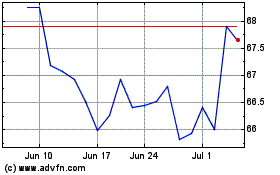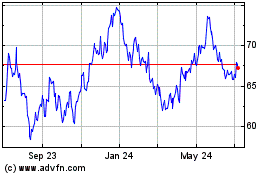Rio Tinto's Iron-Ore Shipments Fall Sharply
April 18 2016 - 9:00PM
Dow Jones News
SYDNEY--Rio Tinto PLC said its shipments of iron ore fell
sharply during the first three months of this year, as the miner
was buffeted by bad weather and exhausted stockpiles of ore at its
remote Australian operations.
The miner also downgraded its expectations for iron ore
production in 2017, citing delays to its new, autonomous railway
system.
One of the world's biggest exporters of the steelmaking
commodity, Rio Tinto has in recent years ratcheted up production
from a vast network of mines in northwest Australia, betting on
strong demand from expanding Asian economies such as China.
That growth stalled last quarter, however, as its operations
faced challenges from a tropical cyclone that hit Western Australia
in late January, the Anglo-Australian miner said Tuesday. Large
stockpiles built up during an expansion of Rio Tinto's
infrastructure network, which helped bolster sales last year, have
also been drawn down.
The company reported global iron-ore shipments of 80.8 million
metric tons for the three months through March, down 12% on the
previous quarter.
The miner, which runs iron-ore operations in Canada as well as
Australia, aims to produce 350 million tons of the commodity
globally this year, up from 328 million tons in 2015. It cut its
projection for output from its Australian mines for 2017 to between
330 million tons and 340 million tons, from 350 million tons
earlier.
Analysts say disruptions to iron-ore supplies more widely in
Australia and Brazil have helped shore up the price of the
commodity, which rose by 24% over the course of the first quarter
and should offset the impact of lower sales on Rio's earnings.
Still, brokers are largely cautious on the outlook for the iron-ore
market, citing expectations of a ballooning global glut.
On Monday, Citi forecast prices would fall below $40 a ton by
the end of the year, from roughly $58 a ton now.
Rio Tinto's first-quarter shipments were 11% higher on year,
after a multibillion-dollar expansion of its Australian iron-ore
network. As recently as 2010, the miner was producing about 240
million tons a year. Other major global miners such as BHP Billiton
Ltd. and Brazil's Vale SA have also increased production.
"We continue to experience volatility in commodity prices across
all markets," said Rio Tinto Chief Executive Sam Walsh, who will
retire in July.
The company abandoned a policy of stable-or-rising dividends
after it slumped to a loss last year, weighed down by write downs
against an iron-ore project in Guinea and uranium assets in
Australia and Canada. In February, Moody's Investors Service
lowered the miner's credit rating, saying the outlook for its
markets, particularly iron ore, was deteriorating.
Rio Tinto has worked to counter weaker commodity prices by
strictly controlling spending, including a global freeze on wages
implemented earlier in the year. This month, it said it intended to
lengthen payment terms with suppliers to free up more cash, but
backtracked on that plan after criticism from contractors and
politicians.
First-quarter production of other commodities was mixed, Rio
Tinto said Tuesday. The miner produced 27% more copper on-quarter,
aided by higher output from large mines such as Escondida in Chile,
and 3% more aluminum, after upgrades to a smelter in British
Columbia, Canada. Output of thermal coal and bauxite were
lower.
Write to Rhiannon Hoyle at rhiannon.hoyle@wsj.com
(END) Dow Jones Newswires
April 18, 2016 20:45 ET (00:45 GMT)
Copyright (c) 2016 Dow Jones & Company, Inc.
Rio Tinto (NYSE:RIO)
Historical Stock Chart
From Mar 2024 to Apr 2024

Rio Tinto (NYSE:RIO)
Historical Stock Chart
From Apr 2023 to Apr 2024
